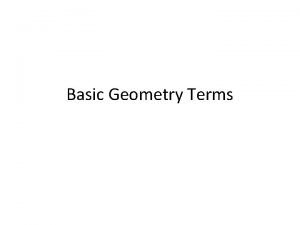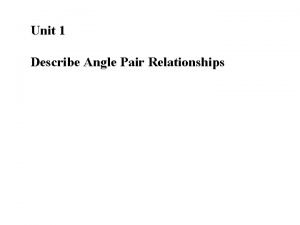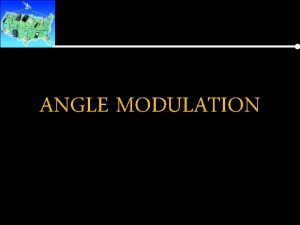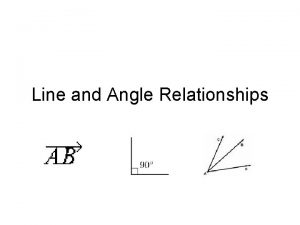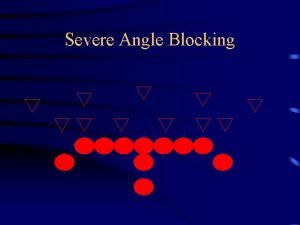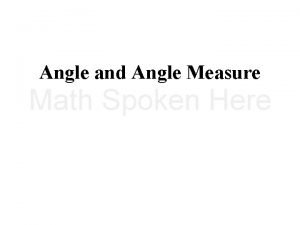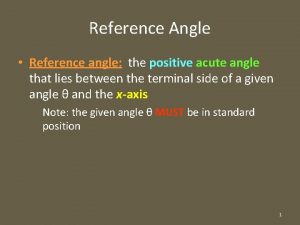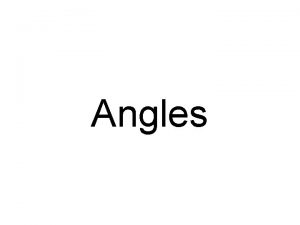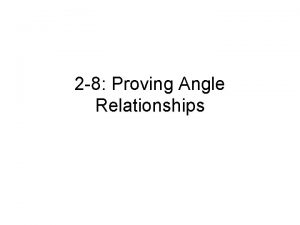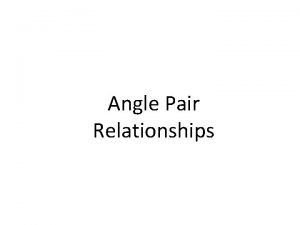Angle Types Relationships Angle two rays that meet












- Slides: 12

Angle Types & Relationships

Angle – two rays that meet at a common vertex Related terminology: Vertex – the point in space at which two lines, line segments, or rays meet. Ray – a set of points in the same plane that contains one defined end point and goes on indefinitely in the other direction. Line – a set of points in the same plane that goes on indefinitely in both directions. Line segment – a part of a line; a set of points that has two defined end points. **An angle can also exist as a pair of lines or line segments that meet at a common vertex. **

Acute Angle – an angle that measures greater than 0 and less than 90 degrees

Obtuse angle – an angle that measures greater than 90 degrees, but less than 180 degrees.

Right angle – an angle that measures exactly 90 degrees Related terminology: ‘perpendicular’……when two lines, line segments, or rays intersect at 90 degree angles, we can say that they are perpendicular to one another.

Adjacent angles – angles that share a common vertex and ray Related terminology: in common language, the word ‘adjacent’ means immediately ‘next to’, so you can think of a pair of adjacent angles as two angles that are right next to one another.

Vertical angles – angles that share a common vertex and are formed from the same two lines: they are always congruent Related terminology: vertical generally means ‘going up & down’, as opposed to horizontal, which means ‘across’; if you are looking at a diagram, a pair of vertical angles can look ‘vertical’, but not necessarily……another way to think of vertical angles is that they are across from one another. Congruent – ‘equal in measure’

Complementary angles – angles whose combined measure equals 90 degrees Complementary angles do not necessarily have to be adjacent.

Supplementary angles – angles whose measures equal a total of 180 degrees Supplementary angles do not have to be adjacent.

I can also say…. . The ‘complement’ of an angle is the amount that would be needed along with that angle to make a total of 90 degrees. The ‘supplement’ of an angle is the amount that would be needed along with that angle to make a total of 180 degrees.

Linear pair – a pair of supplementary angles that are adjacent to one another.

 Vertical angles
Vertical angles Are supplementary angles adjacent
Are supplementary angles adjacent God be with you until we meet again
God be with you until we meet again Ngoại tâm thu thất chùm đôi
Ngoại tâm thu thất chùm đôi Block nhĩ thất độ 2 mobitz 1
Block nhĩ thất độ 2 mobitz 1 Thể thơ truyền thống
Thể thơ truyền thống Thơ thất ngôn tứ tuyệt đường luật
Thơ thất ngôn tứ tuyệt đường luật Chiến lược kinh doanh quốc tế của walmart
Chiến lược kinh doanh quốc tế của walmart Tìm vết của đường thẳng
Tìm vết của đường thẳng Hãy nói thật ít để làm được nhiều
Hãy nói thật ít để làm được nhiều Tôn thất thuyết là ai
Tôn thất thuyết là ai Gây tê cơ vuông thắt lưng
Gây tê cơ vuông thắt lưng Sau thất bại ở hồ điển triệt
Sau thất bại ở hồ điển triệt
